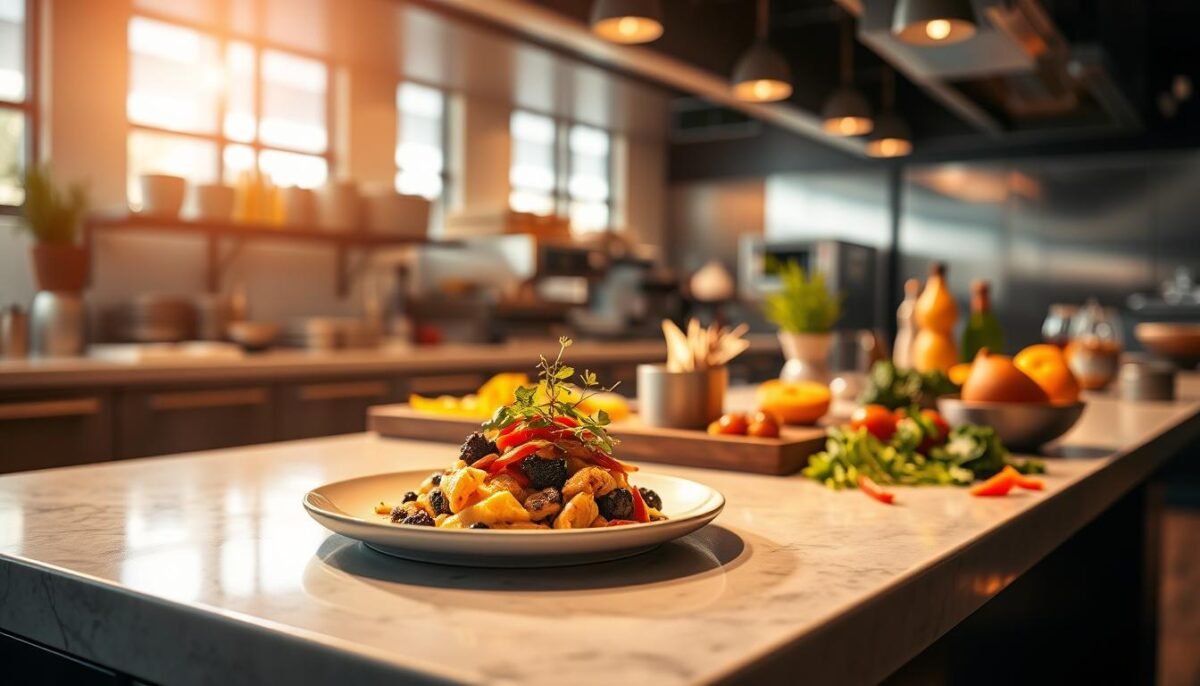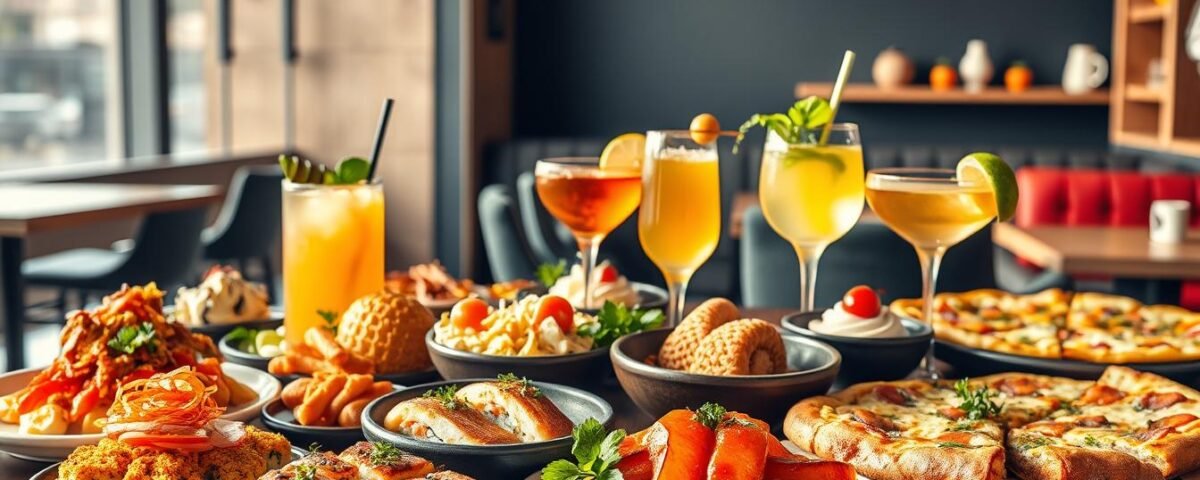
The Secret to Perfect Turkish Baklava: A Complete Guide
March 14, 2025
How to Start a Sushi Restaurant and Make It Profitable
March 15, 2025Did you know that Italian food has been tagged over 20 million times on Instagram? This is just one example of how global flavors are shaping the American dining scene. From the rise of Japanese ramen to the love for Korean barbecue, our plates are becoming more diverse than ever.
Take Sarah, for instance. A busy mom from Chicago, she recently discovered the joy of bubble tea through her teenage daughter. What started as a curiosity has now become a weekly treat for the whole family. Stories like Sarah’s show how these trends are not just fleeting fads but part of our daily lives.
In this article, we’ll explore the top five food trends taking over the U.S. market. We’ll dive into why these flavors matter and how they’re influencing the way we eat. Whether you’re a foodie or just curious, you’ll gain clear insights into the evolution of American dining.
Key Takeaways
- Italian and Japanese cuisines lead in global popularity on social media.
- Korean barbecue and bubble tea are shaping modern dining habits.
- Flavor innovation drives the rise of diverse food trends.
- These trends reflect a growing appetite for global flavors.
- Social media plays a key role in spreading culinary trends.
Introduction to Today’s Food Landscape
The U.S. food scene is evolving faster than ever. Traditional flavors are blending with modern innovations, creating a dynamic dining experience. From small-town eateries to big-city restaurants, the market is buzzing with creativity.
Restaurants are no longer just places to eat. They’re hubs of cultural exchange and experimentation. Chefs are reimagining classic dishes, adding bold twists that captivate diners. This fusion of old and new is shaping the future of American dining.
Setting the Scene in the U.S. Market
The American market is a melting pot of flavors. Iconic dishes like burgers and pizza now share the spotlight with global favorites. Ramen, tacos, and sushi have become staples on menus nationwide.
Social media plays a big role in this shift. Platforms like Instagram and TikTok highlight unique dishes, sparking curiosity and demand. A single viral post can turn a little-known dish into a nationwide sensation.
Our Journey Through Culinary Innovations
Food trends are more than just passing fads. They reflect our changing tastes and values. Plant-based options, for example, are gaining traction as consumers seek healthier, sustainable choices.
Restaurants are adapting quickly, offering innovative menus that cater to these demands. From high-protein meals to functional foods, the focus is on quality and creativity. This journey through culinary innovations is just beginning, and the possibilities are endless.
Understanding What Makes a Cuisine Trendy
What makes a dish go from obscure to iconic in today’s food scene? It’s a mix of creativity, accessibility, and the power of social media. In a world where a single post can spark a global trend, understanding these factors is key.
Defining Trendy Cuisines in a Modern Context
Trendy dishes often combine unique flavors with innovative cooking techniques. They appeal to consumer curiosity and align with current values, like sustainability or health. For example, dishes like sushi burritos or kimchi quesadillas blend cultural traditions in exciting ways.
These creations are not just about taste. They’re also about presentation and storytelling. A dish that looks great on Instagram is more likely to go viral, driving its popularity.
Social Media and Influencer Impact
Platforms like TikTok and Instagram have revolutionized how we discover food. A viral video or a stunning photo can turn a little-known dish into a nationwide sensation. Influencers play a big role here, sharing their experiences and recommendations with millions of followers.
Take the example of dalgona coffee. This whipped coffee drink became a global trend overnight, thanks to TikTok. It’s a perfect example of how social media can propel a dish into the spotlight.
Consumers are increasingly influenced by these online trends. They’re eager to try new flavors and share their experiences, creating a cycle of discovery and popularity.
From innovative ingredient combinations to artistic plating, trendy dishes reflect our evolving tastes. They’re a testament to the power of creativity and the digital age in shaping how we eat.
Global Flavors That Inspire Culinary Creativity
Global flavors are transforming the way we cook and eat. From fusion dishes to sustainable ingredients, the culinary world is embracing diversity like never before. These trends are not just about taste—they’re about creativity, culture, and connection.
Fusion Cuisine: Blending Cultures for Bold Tastes
Fusion dishes are taking the spotlight, combining flavors from different cultures into one unforgettable recipe. Think sushi burritos or kimchi tacos—these creations are bold, innovative, and delicious. They reflect our growing appetite for unique dining experiences.
At home, many are experimenting with fusion cooking. It’s a fun way to explore new flavors while adding a personal twist. Whether it’s a Thai-inspired pasta or a Mexican-style pizza, the possibilities are endless.
Sustainable Ingredients from Around the World
Sustainability is shaping how we source and use ingredients. Chefs and home cooks alike are turning to globally sourced, eco-friendly options. From quinoa to seaweed, these ingredients are not only nutritious but also kind to the planet.
Innovative beverages are also part of this trend. Drinks like matcha lattes and turmeric tonics are gaining popularity for their health benefits and sustainable origins. They’re proof that global flavors can be both delicious and responsible.
- Fusion dishes blend cultures for bold, creative flavors.
- Sustainable ingredients are sourced globally for eco-friendly cooking.
- Innovative drinks and beverages are part of the trend.
- Home cooks are experimenting with international ingredients.
Spotlight on U.S. Market Favorites
The U.S. dining scene is buzzing with excitement as specialty coffee and curated meals take center stage. These trends are not just about food—they’re about experiences that bring people together. From artisanal lattes to multi-course dinners, Americans are embracing innovation in their daily routines.
Specialty coffee has become a cultural phenomenon. With over 40% of U.S. households purchasing plant-based milk, options like oat milk lattes are soaring in popularity. This shift reflects a growing demand for both quality and sustainability in our beverages.
Curated meals are another favorite, offering a blend of convenience and creativity. Many consumers are replacing traditional dinners with balanced, snack-style options. For example, 79% of people are seeking protein-rich snacks, highlighting a focus on health and nutrition.
Localized tastes are shaping the broader culinary landscape. Dishes like cheesesteak sandwiches have seen a 117.6% surge in popularity, while British fusion cuisine appeals to 35% of consumers. These trends show how regional flavors can captivate a national audience.
Here’s a snapshot of how these favorites are influencing consumer behavior:
| Trend | Consumer Impact |
|---|---|
| Specialty Coffee | 40% of households buy plant-based milk; oat milk sales up 22.6% in 2023 |
| Curated Meals | 79% seek protein-rich snacks; 40% replace full meals with snacks |
| Localized Flavors | Cheesesteak popularity up 117.6%; British fusion appeals to 35% |
These trends are more than just passing fads. They reflect a deeper connection between food, culture, and lifestyle. Whether it’s a morning latte or a thoughtfully prepared meal, these favorites are here to stay.
Trendy Cuisines: A Deep Dive into U.S. Culinary Trends
From viral TikTok challenges to innovative protein-packed dishes, the U.S. culinary scene is evolving at lightning speed. Social media platforms like TikTok are driving this transformation, turning once-niche recipes into nationwide sensations. Let’s explore how these trends are shaping menus and inspiring local adaptations.
How TikTok and Digital Trends Shape Menus
TikTok has become a powerhouse for food trends. Viral challenges like the protein-loaded feta pasta or the whipped coffee craze have made their way into restaurants and home kitchens alike. These trends aren’t just fun—they’re reshaping how chefs and home cooks approach meal planning.
For example, traditional meat dishes are getting modern twists. Think smoked brisket tacos or Korean BBQ sliders. These creations are not only delicious but also cater to the growing demand for high-protein meals. Restaurants are quick to adapt, adding these viral hits to their menus to stay relevant.
Local Adaptations and Flavor Innovations
Local chefs are putting their spin on global trends. In New York, you might find a ramen version of a classic cheesesteak. In Los Angeles, sushi burritos are a street food staple. These adaptations highlight the creativity and diversity of the U.S. food scene.
Flavor innovations are also driven by consumer demand. Bold, spicy, and umami-rich profiles are dominating menus. Ingredients like gochujang and harissa are becoming pantry staples, thanks to their versatility and unique taste.
| Trend | Impact |
|---|---|
| TikTok Challenges | Drives viral recipes like feta pasta and whipped coffee |
| Protein-Rich Dishes | Modern twists on traditional meat dishes |
| Local Adaptations | Chefs create unique versions of global trends |
These trends are more than just passing fads. They reflect a deeper connection between food, culture, and technology. Whether it’s a TikTok-inspired dish or a local twist on a classic, the U.S. culinary scene is thriving with innovation.
Innovative Recipes Capturing the Market’s Taste
In today’s fast-paced food scene, innovation is the key to capturing attention. Chefs and home cooks alike are reimagining classic dishes with modern techniques, creating flavors that resonate with today’s consumers. These recipes aren’t just about taste—they’re about creativity, presentation, and timing.

Modern Twists on Classic Dishes
Traditional recipes are getting a fresh makeover. Think mac and cheese with truffle oil or pizza topped with kimchi. These modern twists appeal to our love for nostalgia while introducing bold, new flavors. The media plays a big role here, showcasing these dishes in ways that spark curiosity and demand.
For example, a viral TikTok video can turn a simple recipe into a nationwide sensation. Take the whipped coffee trend—what started as a niche drink became a global phenomenon overnight. This shows how time and place can shape the success of a dish.
Here are a few examples of recipes that have captured the market’s taste:
- Mac and cheese with truffle oil and crispy pancetta.
- Kimchi pizza with a gochujang base.
- Whipped coffee with plant-based milk alternatives.
These dishes reflect a broader trend: the blending of tradition and innovation. They’re proof that even the most familiar recipes can feel fresh and exciting with the right twist.
As the food scene continues to evolve, one thing is clear: creativity is the driving force behind the recipes we love. Whether it’s a classic dish with a modern flair or a completely new creation, these innovations are here to stay.
The Role of Technology in Popularizing New Flavors
Technology has become a game-changer in how we discover and enjoy new flavors. From ordering our favorite snacks to exploring innovative toast recipes, digital platforms are transforming the way we eat. These advancements are not just convenient—they’re reshaping our entire food experience.
In today’s fast-paced world, apps and online systems make it easier than ever to access diverse flavors. Whether it’s a late-night snack or a gourmet meal, technology connects us with the foods we love. This shift is making life more flavorful and exciting for everyone.
Online Ordering and Food Delivery Trends
Online ordering has revolutionized the food industry. Platforms like DoorDash and Uber Eats have made it simple to enjoy restaurant-quality meals at home. These apps are not just about convenience—they’re introducing us to new flavors and trends.
For example, the rise of avocado toast as a breakfast staple was fueled by social media and delivery apps. Similarly, unique snacks like Korean corn dogs or mochi ice cream are gaining popularity through digital platforms. These trends show how technology is shaping our tastes.
Here’s how technology is enhancing our food experience:
- Apps make it easy to order and discover new flavors.
- Delivery services bring restaurant-quality meals to our doorstep.
- Social media inspires us to try trending dishes like avocado toast.
Technology is also making life easier for restaurants. With tools like AI-powered menus and delivery route optimization, businesses can serve customers more efficiently. This boosts sales and ensures we get our favorite foods faster.
As we embrace these innovations, it’s clear that technology is more than just a tool—it’s a gateway to new culinary adventures. From snacks to full meals, it’s changing the way we eat and enjoy food.
For more on how sustainable practices are shaping food delivery, check out the journey of vegetables.
Embracing Plant-Based and Functional Foods
The shift towards plant-based and functional foods is reshaping how we think about our daily meals. More than just a trend, this movement reflects a growing awareness of health and sustainability. From nutrient-packed ingredients to gut-friendly options, these foods are becoming a staple in many households.
Nutritional Advantages and Health-Focused Options
Plant-based foods offer a range of nutritional benefits. They’re rich in vitamins, minerals, and fiber, making them a smart choice for day-to-day eating. Functional ingredients like turmeric and adaptogens add an extra layer of health benefits, supporting everything from digestion to immunity.
Consumers are increasingly turning to these options for their versatility and flavor. Whether it’s a protein-packed smoothie or a hearty plant-based stew, these meals are designed to fuel growth in both energy and well-being. The rise of flexitarianism shows that people are eager to incorporate these foods without giving up their favorite dishes entirely.
Here’s why plant-based and functional foods are gaining traction:
- They provide essential nutrients for day-to-day health.
- Functional ingredients offer targeted benefits, like improved gut health.
- Consumers see them as a way to support long-term growth in wellness.
This evolution in eating habits is more than just a passing phase. It’s a reflection of our desire to make something meaningful out of every meal. As we continue to explore these options, the possibilities for innovation are endless.
Consumer Engagement and Contemporary Branding
In today’s dining culture, storytelling has become a powerful tool for brands to connect with their audience. It’s not just about the food—it’s about the experience, the narrative, and the emotions it evokes. Modern consumers crave more than a meal; they want a story they can share.
Restaurants are leveraging this trend by crafting compelling narratives around their dishes. From the texture of a perfectly seared steak to the ambiance of a cozy bar, every detail contributes to the story. This approach not only enhances the dining experience but also builds a loyal customer base.
Storytelling Through Food Trends
One of the most effective ways to engage consumers is through food trend content. Brands are using social media to share behind-the-scenes stories, chef interviews, and recipe tutorials. These narratives make the food feel personal and relatable.
For example, a viral video of a chef preparing a dish in a bustling bar can create a sense of excitement and authenticity. The texture of the ingredients, the sizzle of the pan, and the vibrant colors all contribute to the story. This type of content resonates deeply with audiences, driving both engagement and sales.
“The way a dish is presented can transform it from a simple meal to a memorable experience.”
Here’s how brands are using storytelling to enhance their appeal:
| Strategy | Impact |
|---|---|
| Showcasing ingredient texture | Creates sensory appeal and builds anticipation |
| Highlighting bar settings | Adds a social and vibrant atmosphere |
| Sharing trend-driven content | Engages audiences and drives curiosity |
These strategies show how contemporary branding ties the physical texture of food with its digital portrayal. By focusing on storytelling, brands can create a deeper connection with their audience, turning casual diners into loyal fans.
Impact on Local Restaurants and Home Kitchens
The way we eat is changing, and it’s not just about what’s on our plates—it’s about where and how we enjoy it. Local restaurants and home kitchens are at the forefront of this transformation, adapting to new trends and consumer demands. From innovative menus to creative home cooking, the impact is undeniable.
Restaurant Menu Innovations and Community Response
Restaurants are reimagining their offerings to stay relevant in a competitive market. Many are introducing health-focused dishes, like tea-infused entrees and antioxidant-rich desserts. These options cater to diners seeking both flavor and wellness.
Community response has been overwhelmingly positive. Diners appreciate the creativity and effort behind these new trends. For example, tea-based cocktails and matcha desserts are becoming staples in many eateries, reflecting a growing interest in functional ingredients.
Home Cooking: Bringing Trendy Cuisines to Your Kitchen
At home, people are experimenting with these trends in their own kitchens. Recipes for tea-infused broths and health-focused snacks are gaining popularity. This shift is driven by the desire to recreate restaurant-quality meals with a personal touch.
Here are some ways to bring these trends into your home:
- Try making matcha lattes or chai-spiced desserts for a flavorful option.
- Incorporate tea leaves into marinades for a unique twist on proteins.
- Experiment with herbal teas in baking for added health benefits.
These options not only enhance your meals but also align with a lifestyle focused on wellness and creativity. Whether dining out or cooking at home, these trends are shaping how we think about food.
Sustainable Practices Driving Culinary Innovation
Sustainability is no longer just a buzzword—it’s a driving force in the culinary world. From eco-friendly packaging to responsible sourcing, the food industry is embracing greener practices. These changes are not only good for the planet but also resonate with consumers who value ethical choices.
One of the most significant shifts is the focus on eco-friendly packaging. Restaurants and brands are ditching single-use plastics for compostable or recyclable materials. This move reduces waste and aligns with consumer demand for environmentally conscious products.
Eco-Friendly Packaging and Responsible Sourcing
Responsible sourcing is another key aspect of sustainability. Chefs and brands are prioritizing ingredients that are ethically grown and harvested. For example, many are turning to locally sourced produce to reduce carbon footprints. This approach not only supports local farmers but also ensures fresher, higher-quality ingredients.
Here’s how sustainable practices are reshaping the industry:
- Eco-friendly packaging reduces waste and appeals to eco-conscious consumers.
- Responsible sourcing ensures ethical and high-quality ingredients.
- Brands that prioritize sustainability build stronger connections with their audience.
Individual actions also play a crucial role. When a person chooses a sustainably packaged product, they contribute to a larger movement. This collective effort drives industry-wide changes, encouraging more brands to adopt green practices.
For instance, 50% of consumers are willing to pay more for eco-friendly packaging, according to McKinsey & Company. This shows how consumer preferences are shaping the market. Brands that adapt to these demands not only gain loyalty but also set new standards for the industry.
As we continue to innovate, sustainability will remain at the heart of culinary progress. From the way we source ingredients to how we package them, every step matters. Together, we can create a food industry that’s both delicious and responsible.
Future Predictions: Next-Level U.S. Food Trends
The future of U.S. food trends is set to redefine how we experience meals, blending innovation with tradition. From advanced kitchen technology to evolving consumer preferences, the culinary landscape is poised for exciting changes. Let’s explore what’s on the horizon.
Forecasting the Next Wave of Culinary Creativity
Experts predict a surge in creative cooking methods that transform everyday ingredients into extraordinary dishes. The kitchen will become a hub of experimentation, with tools like smart ovens and AI-driven recipe apps leading the way. These innovations will make it easier for home cooks to achieve restaurant-quality results.
Milk-based products are also expected to evolve. From oat milk lattes to cashew cheese, plant-based alternatives will continue to dominate. These options cater to both health-conscious consumers and those seeking new taste experiences.
Innovative Concepts and Market Disruption
The food industry is on the brink of major disruption. Fusion dishes, like kimchi tacos and sushi burritos, will gain even more popularity. These creations reflect a growing appetite for bold flavors and unique combinations.
Here’s a snapshot of what to expect:
| Trend | Impact |
|---|---|
| Smart kitchen tech | Revolutionizes home cooking with AI and automation |
| Plant-based milk | Expands into new categories like desserts and snacks |
| Fusion flavors | Combines global influences for bold taste profiles |
“The future of food lies in the seamless blend of technology and creativity, offering consumers both convenience and excitement.” – Industry Expert
As we look ahead, it’s clear that the way we eat will continue to evolve. Whether it’s through innovative kitchen tools or groundbreaking recipes, the possibilities are endless. These trends will not only shape our meals but also the way we connect with food on a deeper level.
Conclusion
As we wrap up our exploration of food trends, it’s clear that innovation is reshaping how we eat. From dinner tables to bakery shelves, these trends are influencing every meal item we enjoy. This year, expect bold flavors and creative combinations to take center stage.
We’ve seen how fusion dishes and sustainable practices are transforming the culinary landscape. These ideas, much like artisan bakery products, inspire us to embrace creativity in our kitchens. Whether it’s a quick snack or a hearty dinner, there’s something exciting for everyone.
Thank you for joining us on this journey into next-level food trends. Here’s to a vibrant year of delicious discoveries and unforgettable meals!
FAQ
What defines a trendy cuisine in today’s market?
A trendy cuisine often combines bold flavors, innovative techniques, and cultural influences. It’s shaped by social media, consumer preferences, and the desire for unique dining experiences.
How does social media influence food trends?
Platforms like TikTok and Instagram amplify food trends by showcasing viral recipes, creative presentations, and new flavors. Influencers and user-generated content play a key role in shaping what’s popular.
What are some examples of fusion cuisine?
Fusion cuisine blends elements from different cultures, like Korean tacos or sushi burritos. It’s all about creating exciting, unexpected combinations that appeal to adventurous eaters.
Why are plant-based foods gaining popularity?
Plant-based foods are trending due to their health benefits, sustainability, and improved taste. Brands like Beyond Meat and Oatly are leading the way in making these options mainstream.
How can I bring trendy cuisines into my home kitchen?
Start by experimenting with global ingredients, trying out fusion recipes, or recreating viral dishes from social media. Online resources and meal kits make it easier than ever to explore new flavors at home.
What role does sustainability play in food trends?
Sustainability is a major driver, with consumers seeking eco-friendly packaging, responsibly sourced ingredients, and brands that prioritize environmental impact.
How do restaurants adapt to trendy cuisines?
Restaurants often update their menus to include popular dishes, experiment with new flavors, and use social media to engage with customers and stay relevant.
What’s next for U.S. food trends?
Expect more focus on functional foods, innovative cooking techniques, and global flavors. Technology and sustainability will continue to shape the future of dining.



